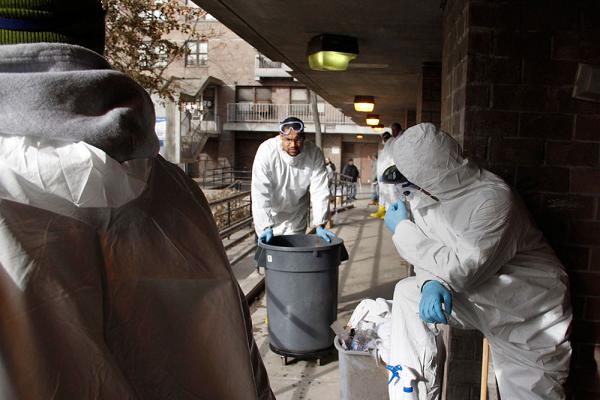
Mold remediation in Coney Island's NYCHA buildings, late 2012.
When Superstorm Sandy ravaged New York in 2012, thousands of low-income apartment-dwellers found themselves in high-rise hell. Many lost power and heat—in some cases, for weeks. Lacking functional elevators, the elderly and disabled were stranded without food, water and medicine. Public housing was hit especially hard: more than 400 buildings managed by the New York City Housing Authority sustained flooding and other damage, affecting some 79,000 residents.
Now, as we approach the third anniversary of that devastating storm, it’s time to revisit the lessons learned—and changes made—since then. If another disaster strikes, will the residents of affordable apartments stay safe?
To answer that question, Enterprise Community Partners and the U.S. Department of Housing and Urban Development (HUD) convened 300 leaders from the affordable housing and resilience communities at a symposium entitled “Ready to Respond: Building Resilience in Affordable Multifamily Housing Communities.” The symposium, held at New York University on August 13, featured a keynote address from Harriet Tregoning, Principal Deputy Assistant Secretary at HUD, followed by two panel discussions with representatives from government agencies and housing organizations.
Panelists described an impressive array of public-sector efforts to support recovery and resilience in the wake of Superstorm Sandy—focusing on the particular challenges for affordable, multifamily housing.
Those challenges are daunting. Affordable apartments—both public and private—took a huge hit from Superstorm Sandy. But federal disaster recovery programs, including FEMA grants, are typically geared toward owner-occupied single-family homes—which account for less than a third of residences in areas flooded by Sandy. That left building owners and managers in the dark (sometimes literally) about how to get help.
Looking ahead, there is clearly a need to bolster the resilience of New York’s affordable multifamily housing, much of which is located in flood-prone areas. For example, simply moving boilers and other mechanical equipment out of the basement can prevent flood damage. But relocating mechanicals can mean the loss of apartment units—a big problem given New York’s acute shortage of affordable housing.
And there are the challenges of retrofitting aging, fully-occupied buildings—including the question of how to pay for improvements without raising rents. Moreover, building owners who fail to meet the federal retrofitting requirements will be hit with much higher insurance premiums under the Biggert-Waters Act, enacted in 2012.
To address these and other challenges, the agencies represented at “Ready to Respond” have launched several initiatives:
• Enterprise Community Partners, with support from HUD, created the Ready to Respond Disaster Staffing Toolkit. The Toolkit addresses the urgent need for information on disaster planning and recovery for multifamily housing. It offers practical strategies to help affordable housing organizations of all sizes manage shocks from major disasters and develop the resilience needed to adapt to future emergencies.
• HUD’s $1 billion National Disaster Resilience Competition helps communities that have been devastated by natural disasters build back stronger. In addition to providing direct support, the competition encourages state and local decision makers to consider resilience in all of their expenditures for new housing, infrastructure, parks and public buildings.
• The Governor’s Office of Storm Recovery launched the New York Rising Community Reconstruction program, a participatory recovery and resiliency initiative established to provide assistance to storm-damaged areas. Unlike traditional top-down approaches to disaster recovery, NYRCR directly engages local residents and business owners in a democratic, bottom-up approach to rebuilding communities.
• NYC’s Department of Housing Preservation and Development is incorporating resiliency measures into a broader set of preservation and affordability goals. Notably, the Multifamily Resiliency Retrofit Program is providing capital improvements and energy efficiency upgrades, in an effort to leverage disaster recovery funding to improve the city’s affordable housing stock.
• The New York City Housing Authority—the nation’s largest public landlord—is integrating resilience goals into its NextGeneration NYCHA strategic plan. NYCHA will deploy a $3 billion grant from FEMA (the largest FEMA grant in history) to repair and protect some 200 buildings—elevating boilers, installing flood barriers and standby generators. Where possible, NYCHA will install micro-grids, which can produce power for residents when the larger electric grid goes down.
Panelists also reported on critical lessons learned from these efforts. For example:
• Seize the “collaboration dividend.” Partnerships across agencies and sectors produce outsized benefits, by leveraging the unique strengths and expertise of each partner.
• Listen to the community. No one knows a community’s strengths and weaknesses better than residents themselves. For example, community-based organizations can help identify vulnerable residents—those on dialysis, or with limited mobility. That’s why community input is the key to feasible, responsive resilience planning.
• Make sure investments do double (or triple, or quadruple) duty. Ensure that investments in housing yield multiple benefits—including resilience, sustainability, affordability, and economic vitality. For example, weatherization and efficiency measures can reduce energy costs for tenants and building owners, while making it more comfortable to “shelter in place” during power outages. They can also provide jobs for community residents. And, as a bonus, those measures reduce emissions that contribute to climate change.
• Don’t plan just for the last event. Sandy was a surge event, but the next emergency to affect New York City could be a windstorm, a terrorist attack or an epidemic. When allocating disaster recovery dollars, think of resiliency in broad terms, and apply available funds to measures that can enhance a building or community’s resiliency to a wider range of climate—and other— impacts.
Much has been accomplished since Sandy, but more remains to be done. And the stakes are high: it is increasingly clear that a changing climate will bring rising seas, stronger storms and higher temperatures. Already, extreme weather events are increasing in frequency and severity: Between 2011 and 2013 the President declared major disasters in more than 2,100 different counties—over two-thirds of all counties in the nation.
Affordable multifamily housing, which shelters our most vulnerable citizens, must be ready to respond.
Laurel Blatchford is the senior vice president for solutions at Enterprise Community Partners








